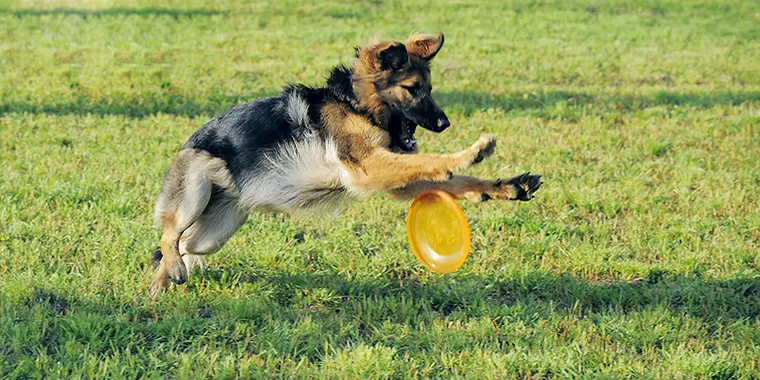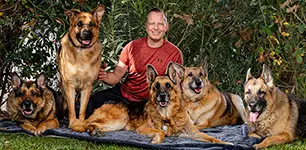
Are dog parks safe? Dog parks can be fun for dogs and people. You can bring your dog to these fenced areas to socialize and play off-leash games. Play with other dogs or whatever else you and your furry companion might enjoy doing. Dog parks are a great way to add variety to your dog’s routine. It helps with their biological fulfillment and results in a happier dog.
However, most of us have probably seen how one single, misbehaved, hyper-active, or simply very pushy dog can change the entire atmosphere at a dog park in an instant; creating a not-so-safe environment. Whoever brought that dog in usually earns nasty looks from the other dog owners but more importantly, it turns what should be a fun time for people and their dogs into a stressful situation for everyone involved. That dog park is no longer safe.
Let’s review a couple of simple tips on how you can do your part to ensure that dog parks are fun for everyone and remain as safe as possible for all people and dogs.
Before You Go
A key ingredient for a great dog park experience is the state of mind your dog is in before he even gets into any dog park. Take your dog on a nice, long walk or exercise him by riding your bike, rollerblading, using a treadmill, or whatever your routine might be. Avoid using a dog park to substitute what you and your dog could do together and bond over. Get your furry friend a bit tired before you let him join the other dogs. It helps to keep everyone in the dog park safe if your friend enters with the right attitude.
Before You Go In
Ideally, you should be walking through the gates of the dog park first. Try having your doggy sit outside the gate (on a leash, of course) and wait for you to ask him to enter while you walk and then call him in. Have him sit down again and wait while you remove the leash and only then release him to begin his playtime.
He’s there to have fun but still hold your dog accountable in some manner. By asking for some impulse control, you are setting him up for success. It will result in a better-behaved doggy and a better dog park experience. If there are two gates to pass through—there usually are—make sure you pass through both in this fashion.
This might not be that easy to accomplish the first time you try this, especially when there are many excited dogs inside the park curiously checking out the newcomer. Don’t be discouraged if it takes a while in the beginning. But make an effort to enter the park orderly—just be patient. Wait for your dog to calm down before you move on.
It is good practice to make your dog wait like that going in to or out of any area, room or door no matter where you are. You can practice this pretty much anywhere, and it makes a big difference in how your dog looks at you. This is not about being a pack leader. This is about teaching your dog impulse control. It helps to keep the dog park safe. Further, it shows your dog that you’re a conduit to great things. He just has to listen first.
While You Are There
Always keep an eye on your dog. You are still responsible for what your dog does, even if you are in an off-leash dog park. Check if he is behaving properly and step in if he isn’t. If he is showing pushy or rowdy behaviors, step in and communicate your disagreement. It is not okay to pester other dogs or make them uncomfortable, and so on. Please do your part to keep the dog park safe for everyone. The other dog owners will be grateful to see that you are keeping an eye on your dog.
This, of course, goes both ways. If you see another dog misbehaving and an owner not doing anything about it, don’t judge. They might not know that their dog is doing something that can lead to trouble. Strike up a friendly conversation and offer some tips to keep everyone safe. Most dog owners are very open to listening as long as you’re nice. They want the dog park to be safe for their dog, too, and might not know what is happening.
Dog parks are a great environment to watch your dog being a dog amongst his species. It is very educational and fun just to watch them play. Leave that cell phone in your pocket, chat with some fellow other dog owners and always keep an eye on Buster.
Make Sure Your Dog Has Water
Most dog parks have water fountains of some sort. Make sure your doggy gets enough water while you are there. If he runs around a lot, he also needs to drink a lot. If you are unsure about the water supply situation, ensure to have enough water in the car so you can get it if necessary. Of course, you shouldn’t leave your dog unsupervised to do that. If you’re by yourself, you might have to take your buddy with you to make that trip. It is also a good idea to invest in a foldable water bowl you can stuff in a pants pocket and carry with you. Even if there is a water fountain, it can still be out of commission.
And, of course, adhere to all dog park rules. They are posted outside the park and are designed to keep everyone safe. More on that later.
Heading Home
Leaving the dog park should take place in the same orderly fashion outlined above for entering. Call your dog to you instead of running after him trying to catch him. If he doesn’t come when called, it might be good to train him. It makes things a lot easier. Have him sit down, put the leash on and walk out the same way you came in. Again, take your time. It is more important for your dog to learn to do it correctly than to do it fast. Again, it’s all about you and your dog helping to keep the dog park safe.
Dog Park Rules
The dog park “rules of conduct” are usually posted outside the park, and it is a good idea to read them the first time you come. Not following the rules can lead to being asked to leave. These rules are designed to keep the dog park safe for everyone and ensure the dog park remains a peaceful, fun place for all. There are many incidences of dog fights in dog parks each year, and all of them are usually a result of either not following the posted rules or not keeping an eye on your doggy as he engages with the other dogs.
Many rules relate to dog registration, dog tags, spaying and neutering, vaccinations, flea and tick prevention, and age restrictions. These are all very reasonable things that make a lot of sense when dogs get together. Let’s first look at some important rules and then at some more questionable ones. You will still need to follow those also, but it is always good to know what is important and what is less so. If you have a perfectly behaved, social dog with no issues, many of these rules can seem over-protective. However, remember that most dogs are not perfectly behaved, and these rules are designed for the average visitor.
Dog Parks Have Risks
Dog parks can be fun but they also are risky. There is basically a dog fight in almost every dog park every day. The question is only if you and your dog will be present at that time. You can visit your local dog park for years at the same time every day and see the same people. All the dogs know each other and play nicely together. Then, one day, you go at a different time and see a dog fight. Or a new person moves into the neighborhood and has a dog that shouldn’t be in a dog park. All of a sudden, your dog park is no longer safe. The rules are supposed to reduce the risk but I’m not sure they do. Regardless, we have to follow them.
Keeping Large and Small Dogs Separate
Most dog parks have separate areas for smaller and larger dogs. Make sure you go to the right area. If you have a puppy, the small dog park might be more appropriate to get started while the puppy is small. Even if you have a large breed dog, that eventually should go to the large dog area. Just be sure to switch to the large dog area once your puppy is too big for the little ones.
Keeping large and small dogs separate is essential for several reasons. Larger dogs, especially working, herding, and hunting breeds, tend to have a stronger prey drive. They may look at small, furry things that move and make noise as, well, prey. For example, your dog takes an interest in chasing cats, squirrels, or rabbits, and you haven’t been able yet to explain to him that such behavior is not desired. Chances are good, he will not care much for small dogs either. This is especially true if they behave in a dominating or challenging manner.
Further, keep in mind that fights happen regularly at any dog park. If the dogs involved are of comparable size, any damage will probably be less severe. That is different if it happens between larger and smaller dogs. In such cases, especially owners of larger dogs will often get blamed by the owners of smaller dogs. Even if the smaller dog started the altercation. That the little guy has little-to-no chance of winning a confrontation against a ten times larger dog doesn’t stop him. To dogs, size doesn’t matter as much as each other’s energy. To keep the dog park safe, keep different-sized dogs separate.
Limit the Number of Dogs per Owner
Most dog parks limit the number of dogs anyone can bring in simultaneously to two or three. That is a good rule, as it is pretty hard to keep an eye on two dogs already. What would you do should both dogs get into trouble simultaneously at different ends of the park? I recommend only bringing one dog per person. It’s the smart thing to do. No matter how well your dogs behave, other dogs are always to consider. If you have more than one dog, consider bringing some friends to help keep the dog park safe.
As good as it is to be able to keep an eye on all dogs you bring, this is usually not the reason dog parks have this rule. The reason this rule was established was to prevent dog walkers from just taking all the dogs they pick up to some dog park. Too many did this instead of walking them. It is a valid point, as it directly links back to the above.
Dogs Can’t be On Leash Inside the Dog Park
This is a rule at some dog parks, and the reasoning is usually that dogs on leashes surrounded by other dogs supposedly become more aggressive. This is a highly questionable claim and is not supported by any facts. It is likely based on people’s incorrect interpretations of why dogs pull on leashes when meeting other dogs. The leash pulling has more to do with a lack of clarity about the environment or ritualistic behaviors than anything else. Establishing this as a dog park rule seems ill-informed.
However, this rule does not exist at all dog parks, and walking a dog around on a leash inside a dog park can be an effective way of socializing a dog more safely. Also, when you take your dog to the park for the first time, a leash allows you to introduce him to other dogs while maintaining complete control. For this reason, this rule seems counterproductive for a dog park and, given the lack of evidence of its benefits, somewhat strange. I recommend you look for dog parks that don’t have this rule if you want to leash your dog in the park for whatever reason. There are plenty of dog parks where you can.
No Treats in the Dog Park
Something equally strange is restrictions on bringing food into a dog park. I heard this being reasoned as “dogs will follow you around and not play with other dogs.” This, however, is hardly supported by what dogs do in a dog park when treats are present. They might sniff the treats out and try to get one. However, if they don’t succeed, they will just move on and do something else—remember, there are many other things to do in a dog park. There is no reason for such a restriction, but it does exist at more and more dog parks. It also hinders performing any kind of treat-based training activities, like teaching your dog to come when called inside a dog park. It is an excellent place to train with distractions once your dog learns to do it without distractions.
That’s it. These are the basic rules to keep the dog park safe and make the experience a positive one for all participants. I hope you find these tips helpful, and if you need help getting your dog ready for socialization, you know how to find me.
An earlier version of this article was also published at 4Knines.com.
Play the Audio





